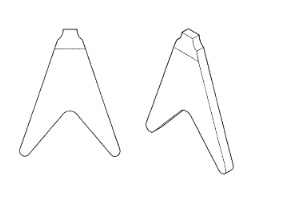The iconic shape of the GIBSON flying V electric guitar body has recently been considered by courts in the US and the European Union with confusing and perhaps surprising results. The flying V shape has been made famous through the use of guitars of this shape by several very well-known rock 'n' roll artists. The guitar has also been portrayed in numerous movies.
Gibson Brands Inc. (Gibson") owns a US trademark registration for the flying V shape and a Canadian registration for a distinguishing guise. The drawing from the Canadian registration is reproduced below.

The European Union
Gibson successfully applied for registration of the flying V shape in the EU. However, the registration was cancelled in proceedings brought before the Cancellation Division of the EUIPO. The Second Board of Appeal of the EUIPO dismissed an appeal. The Board concluded that even if electric guitars with V-shaped bodies were very unusual when they were released in 1958, that shape was now perceived as one possible variant of many shapes of electric guitars in the marketplace and no longer departed significantly from the norms and customs of the electric guitar sector when the application was filed in 2010. In addition, the presence in the marketplace of other electric guitars with a V shape made by manufacturers other than Gibson in 2010 was significant. Consumers would not base their decision to purchase solely on the V-shape as an indication of origin since the shape was devoid of inherent distinctive character. Regarding distinctiveness acquired by use, the evidence filed by Gibson did not satisfy the requirements of the court. A further appeal to the General Court of the EU was dismissed.
The US
Gibson brought an action for trademark infringement in the United States District Court for the Eastern District of Texas, Sherman Division, against companies selling guitars with a V-shaped body. The trial has recently been completed before a jury. In its verdict, the jury concluded that the defendants had infringed the flying V body shape, among other Gibson trademarks. The jury also said that Gibson had delayed in asserting its trademark rights against the defendants and that the delay was inexcusable and caused undue prejudice to the defendants. The jury was not satisfied that Gibson had shown that it suffered damages but ordered counterfeiting statutory damages of $4000. The jury refused to order that Gibson's trademark registration be cancelled on the basis the mark was generic. This litigation may not be at an end.
Canada
Gibson owns a distinguishing design registration for the flying V body shape, among others, so that it could bring an action for infringement in Canada. In such an action, it would be open to the defendant to seek to expunge the registration on the basis that the applied-for mark is not distinctive. However, the onus in such proceedings is on the attacking to prove its case at the time of bringing the proceeding raising the issue. If a mark is generic, this can support such an attack.
The concept of a distinguishing guise has been removed from the Trademarks Act, but the same concept is now included within the definition of a "sign" subject to a requirement to establish "distinctiveness" during the examination.
Comment
A trademark owner cannot stand by and let its mark be infringed. Widespread infringing use can support an attack on a registration on the basis of non-distinctiveness.
Originally Published by Lawyer's Daily published by LexisNexis Canada Inc.
The content of this article is intended to provide a general guide to the subject matter. Specialist advice should be sought about your specific circumstances.


